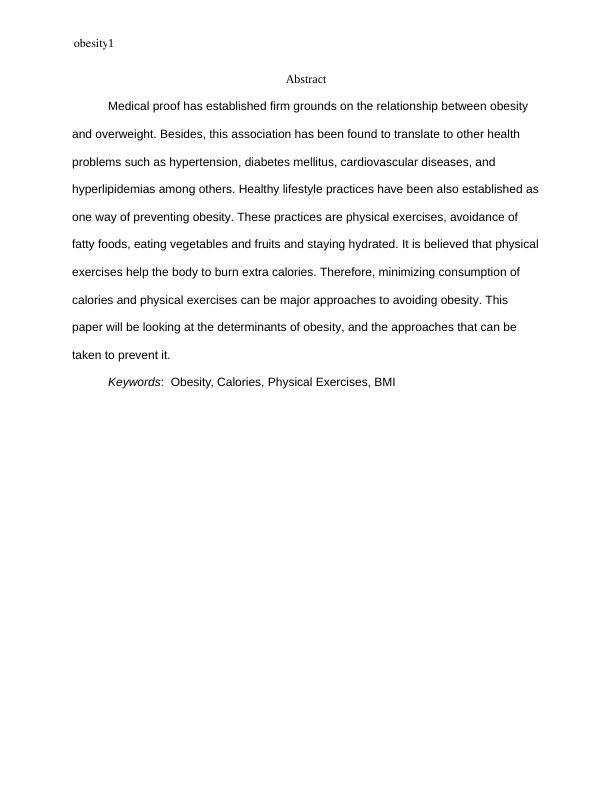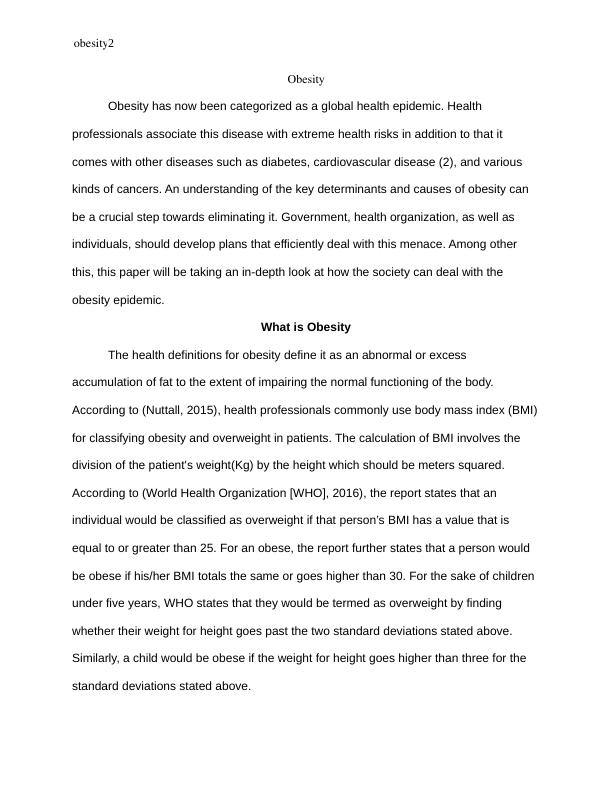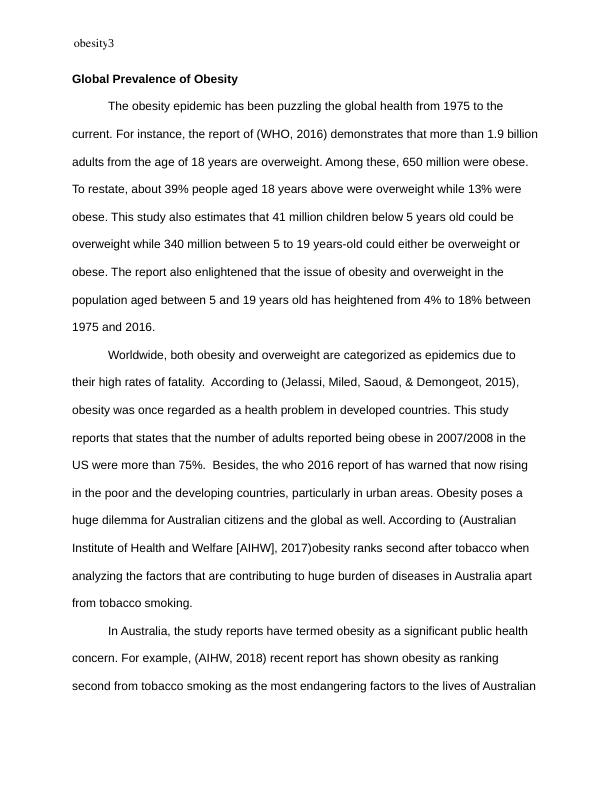Obesity: Determinants and Prevention Approaches
Added on 2023-06-14
13 Pages3511 Words469 Views
Running head:
Author Name(s)
Institutional Affiliation(s)
Author Note
Author Name(s)
Institutional Affiliation(s)
Author Note

1
Abstract
Medical proof has established firm grounds on the relationship between obesity
and overweight. Besides, this association has been found to translate to other health
problems such as hypertension, diabetes mellitus, cardiovascular diseases, and
hyperlipidemias among others. Healthy lifestyle practices have been also established as
one way of preventing obesity. These practices are physical exercises, avoidance of
fatty foods, eating vegetables and fruits and staying hydrated. It is believed that physical
exercises help the body to burn extra calories. Therefore, minimizing consumption of
calories and physical exercises can be major approaches to avoiding obesity. This
paper will be looking at the determinants of obesity, and the approaches that can be
taken to prevent it.
Keywords: Obesity, Calories, Physical Exercises, BMI
Abstract
Medical proof has established firm grounds on the relationship between obesity
and overweight. Besides, this association has been found to translate to other health
problems such as hypertension, diabetes mellitus, cardiovascular diseases, and
hyperlipidemias among others. Healthy lifestyle practices have been also established as
one way of preventing obesity. These practices are physical exercises, avoidance of
fatty foods, eating vegetables and fruits and staying hydrated. It is believed that physical
exercises help the body to burn extra calories. Therefore, minimizing consumption of
calories and physical exercises can be major approaches to avoiding obesity. This
paper will be looking at the determinants of obesity, and the approaches that can be
taken to prevent it.
Keywords: Obesity, Calories, Physical Exercises, BMI

2
Obesity has now been categorized as a global health epidemic. Health
professionals associate this disease with extreme health risks in addition to that it
comes with other diseases such as diabetes, cardiovascular disease (2), and various
kinds of cancers. An understanding of the key determinants and causes of obesity can
be a crucial step towards eliminating it. Government, health organization, as well as
individuals, should develop plans that efficiently deal with this menace. Among other
this, this paper will be taking an in-depth look at how the society can deal with the
obesity epidemic.
What is Obesity
The health definitions for obesity define it as an abnormal or excess
accumulation of fat to the extent of impairing the normal functioning of the body.
According to (Nuttall, 2015), health professionals commonly use body mass index (BMI)
for classifying obesity and overweight in patients. The calculation of BMI involves the
division of the patient's weight(Kg) by the height which should be meters squared.
According to (World Health Organization [WHO], 2016), the report states that an
individual would be classified as overweight if that person’s BMI has a value that is
equal to or greater than 25. For an obese, the report further states that a person would
be obese if his/her BMI totals the same or goes higher than 30. For the sake of children
under five years, WHO states that they would be termed as overweight by finding
whether their weight for height goes past the two standard deviations stated above.
Similarly, a child would be obese if the weight for height goes higher than three for the
standard deviations stated above.
Obesity has now been categorized as a global health epidemic. Health
professionals associate this disease with extreme health risks in addition to that it
comes with other diseases such as diabetes, cardiovascular disease (2), and various
kinds of cancers. An understanding of the key determinants and causes of obesity can
be a crucial step towards eliminating it. Government, health organization, as well as
individuals, should develop plans that efficiently deal with this menace. Among other
this, this paper will be taking an in-depth look at how the society can deal with the
obesity epidemic.
What is Obesity
The health definitions for obesity define it as an abnormal or excess
accumulation of fat to the extent of impairing the normal functioning of the body.
According to (Nuttall, 2015), health professionals commonly use body mass index (BMI)
for classifying obesity and overweight in patients. The calculation of BMI involves the
division of the patient's weight(Kg) by the height which should be meters squared.
According to (World Health Organization [WHO], 2016), the report states that an
individual would be classified as overweight if that person’s BMI has a value that is
equal to or greater than 25. For an obese, the report further states that a person would
be obese if his/her BMI totals the same or goes higher than 30. For the sake of children
under five years, WHO states that they would be termed as overweight by finding
whether their weight for height goes past the two standard deviations stated above.
Similarly, a child would be obese if the weight for height goes higher than three for the
standard deviations stated above.

3
Global Prevalence of Obesity
The obesity epidemic has been puzzling the global health from 1975 to the
current. For instance, the report of (WHO, 2016) demonstrates that more than 1.9 billion
adults from the age of 18 years are overweight. Among these, 650 million were obese.
To restate, about 39% people aged 18 years above were overweight while 13% were
obese. This study also estimates that 41 million children below 5 years old could be
overweight while 340 million between 5 to 19 years-old could either be overweight or
obese. The report also enlightened that the issue of obesity and overweight in the
population aged between 5 and 19 years old has heightened from 4% to 18% between
1975 and 2016.
Worldwide, both obesity and overweight are categorized as epidemics due to
their high rates of fatality. According to (Jelassi, Miled, Saoud, & Demongeot, 2015),
obesity was once regarded as a health problem in developed countries. This study
reports that states that the number of adults reported being obese in 2007/2008 in the
US were more than 75%. Besides, the who 2016 report of has warned that now rising
in the poor and the developing countries, particularly in urban areas. Obesity poses a
huge dilemma for Australian citizens and the global as well. According to (Australian
Institute of Health and Welfare [AIHW], 2017)obesity ranks second after tobacco when
analyzing the factors that are contributing to huge burden of diseases in Australia apart
from tobacco smoking.
In Australia, the study reports have termed obesity as a significant public health
concern. For example, (AIHW, 2018) recent report has shown obesity as ranking
second from tobacco smoking as the most endangering factors to the lives of Australian
Global Prevalence of Obesity
The obesity epidemic has been puzzling the global health from 1975 to the
current. For instance, the report of (WHO, 2016) demonstrates that more than 1.9 billion
adults from the age of 18 years are overweight. Among these, 650 million were obese.
To restate, about 39% people aged 18 years above were overweight while 13% were
obese. This study also estimates that 41 million children below 5 years old could be
overweight while 340 million between 5 to 19 years-old could either be overweight or
obese. The report also enlightened that the issue of obesity and overweight in the
population aged between 5 and 19 years old has heightened from 4% to 18% between
1975 and 2016.
Worldwide, both obesity and overweight are categorized as epidemics due to
their high rates of fatality. According to (Jelassi, Miled, Saoud, & Demongeot, 2015),
obesity was once regarded as a health problem in developed countries. This study
reports that states that the number of adults reported being obese in 2007/2008 in the
US were more than 75%. Besides, the who 2016 report of has warned that now rising
in the poor and the developing countries, particularly in urban areas. Obesity poses a
huge dilemma for Australian citizens and the global as well. According to (Australian
Institute of Health and Welfare [AIHW], 2017)obesity ranks second after tobacco when
analyzing the factors that are contributing to huge burden of diseases in Australia apart
from tobacco smoking.
In Australia, the study reports have termed obesity as a significant public health
concern. For example, (AIHW, 2018) recent report has shown obesity as ranking
second from tobacco smoking as the most endangering factors to the lives of Australian

End of preview
Want to access all the pages? Upload your documents or become a member.
Related Documents
Childhood Obesity Facts & Statisticslg...
|4
|2365
|478
Obesity and the Social Burden Caused by Obesitylg...
|11
|4400
|68
Obesity Health Challengelg...
|11
|2377
|119
ASSIGNMENTS ON OBESITY DISEASElg...
|13
|3631
|22
Obesity Prevention and Health Promotionlg...
|14
|3383
|96
A Report on Childhood Obesitylg...
|9
|1533
|25
